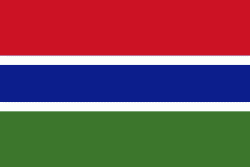Abuko
Abuko is a town in the West Coast Division of the Gambia, five miles southwest of the capital Banjul. It is located in the district of Kombo North/Saint Mary to the north of Banjul International Airport and Abuko Nature Reserve.
Abuko is in the West Coast Division, in the western part of the country, 10 km south-west of the capital city Banjul. It had 6,572 inhabitants as of 2012. The area around Abuko is well-populated, with 1,056 people per square kilometer. The nearest larger city is Serekunda, 4.5 km north-west of Abuko. The town is home to the Abuko United FC.
The 259 acre Abuko Nature Reserve, created in 1968, lies to the south of the town. It is the most visited tourist attraction in Gambia, with over 30,000 visitors annually. It contains tropical canopy forest near the Lamin Stream, giving way to Guinean savanna further from the water. The reserve is home to many species of bird, four primates and a variety of reptiles.
Abuko is in the West Coast Division, in the western part of the country, 10 km south-west of the capital city Banjul. It had 6,572 inhabitants as of 2012. The area around Abuko is well-populated, with 1,056 people per square kilometer. The nearest larger city is Serekunda, 4.5 km north-west of Abuko. The town is home to the Abuko United FC.
The 259 acre Abuko Nature Reserve, created in 1968, lies to the south of the town. It is the most visited tourist attraction in Gambia, with over 30,000 visitors annually. It contains tropical canopy forest near the Lamin Stream, giving way to Guinean savanna further from the water. The reserve is home to many species of bird, four primates and a variety of reptiles.
Map - Abuko
Map
Country - The_Gambia
 |
 |
The Portuguese in 1455 entered the Gambian region, the first Europeans to do so, but never established important trade there. In 1765, the Gambia was made a part of the British Empire by establishment of the Gambia. In 1965, the Gambia gained independence under the leadership of Dawda Jawara, who ruled until Yahya Jammeh seized power in a bloodless 1994 coup. Adama Barrow became the Gambia's third president in January 2017, after defeating Jammeh in the December 2016 elections. Jammeh initially accepted the results, before refusing to leave office, triggering a constitutional crisis and military intervention by the Economic Community of West African States that resulted in his removal two days after his term was initially scheduled to end.
Currency / Language
| ISO | Currency | Symbol | Significant figures |
|---|---|---|---|
| GMD | Gambian dalasi | D | 2 |
| ISO | Language |
|---|---|
| EN | English language |
| WO | Wolof language |















